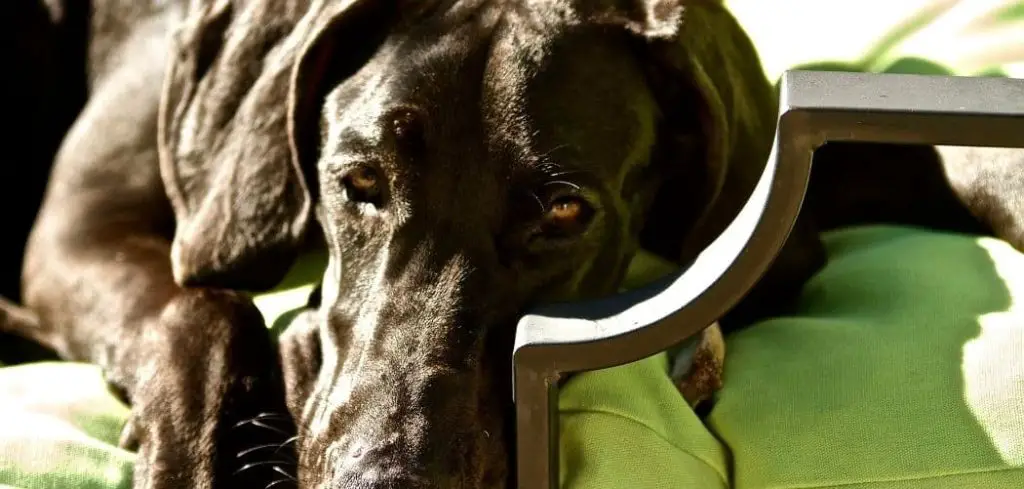Diarrhea in dogs after a diet change can be alarming, especially if it comes on suddenly. Diarrhea in dogs after a food change is a common but concerning issue for many dog owners.
We outline the common causes of diarrhea in dogs due to a change in food, what you can do at home, and when to seek veterinary help.
Dog Diarrhea Due to Food Change — Why It Happens
A sudden switch in diet can disrupt your dog’s digestive balance, leading to loose stools, discomfort, and occasional vomiting. Sensitive stomachs, lack of gradual transition, food intolerances, and underlying health issues can all play a role.
The severity can range from mild and short-lived to more persistent diarrhea that signals a bigger problem.

Common Causes of Diarrhea in Dogs Due to Food Change
Sudden Dietary Transition
Switching your dog’s food too quickly can overwhelm their digestive system. Dogs need time to adjust to new ingredients, textures, and nutrient profiles.
Without a gradual introduction, gut bacteria can be disrupted, leading to loose stools within 24–48 hours.
You may notice additional signs like flatulence, abdominal discomfort, and mild lethargy.
While many cases resolve once their system adapts, prolonged diarrhea can cause dehydration and nutrient loss.
Read more: Dog Diarrhea Due To Stress (Here’s why)
Food Sensitivities or Allergies
Even if a food is marketed as healthy, your dog may react negatively to certain proteins, grains, or additives.
Food sensitivities can cause inflammation in the intestines, leading to chronic or recurring diarrhea.
If your dog also shows signs such as itchy skin, ear infections, or frequent paw licking alongside diarrhea, an intolerance or allergy may be the root cause.
These cases often require diet elimination trials guided by a vet.
Rich or Fatty Ingredients
Some new foods, particularly those high in fat or seasoning, can trigger digestive upset.
Rich ingredients can stimulate excess bile production, resulting in loose or oily stools.
High-fat meals can also exacerbate pancreatitis in susceptible dogs, leading to diarrhea paired with vomiting, severe lethargy, and abdominal pain — a veterinary emergency.
Change in Fiber Content
Fiber plays a key role in stool consistency. A sudden jump or drop in dietary fiber from a new food can cause diarrhea as your dog’s gut adjusts.
Too much fiber can speed up digestion, while too little can leave stools loose.
Over time, most dogs adapt, but those with sensitive digestion may need a more balanced fiber adjustment.
Underlying Digestive Disorders
Sometimes, a diet change triggers symptoms of pre-existing digestive issues like inflammatory bowel disease, exocrine pancreatic insufficiency, or intestinal infections.
In these cases, diarrhea may persist beyond a few days and be accompanied by weight loss, poor appetite, or blood in stools.
If symptoms linger, your vet may recommend diagnostic tests to rule out chronic conditions.
Contaminated or Spoiled Food
On rare occasions, diarrhea after a diet change is due to food contamination or spoilage. Bacterial or fungal growth can cause acute gastrointestinal illness.
If your dog develops sudden, severe diarrhea with vomiting, fever, or blood in stools soon after starting a new food, stop feeding it and contact your vet immediately.
What to Do If Your Dog Has Diarrhea After a Food Change
If your dog develops mild diarrhea shortly after switching food but is otherwise acting normal, you can often manage it at home.
Offer plenty of fresh water to prevent dehydration, and consider feeding a bland diet of boiled chicken and rice for 24–48 hours before slowly reintroducing the new food.
When reintroducing, mix the new and old foods together, starting with 75% old and 25% new, gradually increasing the new food over 7–10 days.
You may also add a probiotic supplement to help restore healthy gut bacteria.
Avoid treats or table scraps during this adjustment period, as they can further irritate the digestive system.
When to Call or Visit Your Vet
Contact your veterinarian promptly if your dog’s diarrhea lasts more than 48 hours, is accompanied by vomiting, lethargy, loss of appetite, or blood in the stool.
Puppies, senior dogs, and those with pre-existing health conditions are more vulnerable to dehydration and may require quicker intervention.
Seek emergency care if your dog shows signs of severe weakness, persistent vomiting, a distended abdomen, or sudden collapse.
These symptoms can indicate a more serious underlying issue.
Read more: Dog Diarrhea Due To Medication (Here’s why it happens)
Key Takeaway
Diarrhea after a food change is often the result of a too-rapid transition, ingredient sensitivities, or changes in nutrient balance.
While many cases are mild and resolve with at-home care, persistent or severe symptoms warrant a vet visit to rule out underlying illness.
By introducing new foods gradually, monitoring your dog’s response, and seeking timely veterinary advice when needed, you can keep your pet comfortable and healthy during dietary changes.
